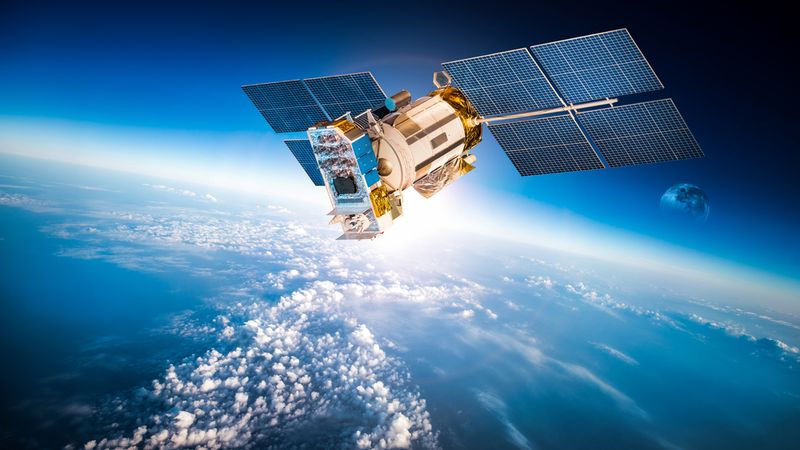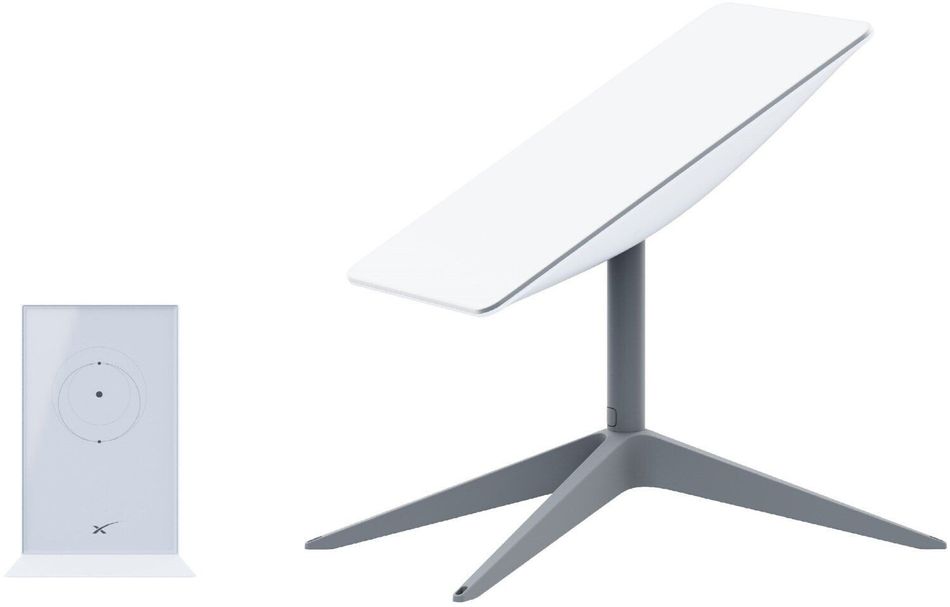From Earth to Orbit: How Advanced Semiconductors Drive Secure, Efficient and Reliable Satellite Communication Systems
Innovative Solutions for Optimizing LEO/MEO Satellite Network Performance.

Satellite communications enable global connectivity, especially in remote and underserved areas where traditional networks are limited. It supports essential services like weather forecasting, disaster management, and global broadcasting. In this regard, Low Earth Orbit (LEO) and Medium Earth Orbit (MEO) satellite connectivity enhances satellite communication by providing lower latency, higher speeds and great accessibility compared to traditional geostationary satellites. However, LEO satellite communication systems face challenges such as power efficiency, reliability, RF performance, security, and cost efficiency.
This article discusses Infineon's role in addressing these challenges through a broad portfolio of solutions, including advanced power management systems, robust RF components, and secure communication technologies. These solutions are designed to optimize performance, enhance system resilience, and reduce operational costs for LEO/MEO satellite networks.
Power Solutions for LEO and MEO Satellites and User Terminals
High-Reliability Space-Qualified Power Components for LEO/MEO satellites
Radiation-Tolerant MOSFETs
The power infrastructure of any satellite system is extremely important for its functionality. The space environment vastly differs from Earth's, posing numerous challenges such as intense radiation exposure, extreme temperature fluctuations, and the vacuum of space. Therefore, the power infrastructure must also be robust enough to tolerate space conditions without compromising performance. LEO/MEO Satellites are exposed to lower radiation levels compared to GEO satellites and typically the mission lifetimes are below 5 years. In this context, radiation-tolerant semiconductors are critical for the reliability and longevity of power systems in LEO satellite environments.
Infineon's radiation-tolerant MOSFETs are specifically designed to address challenges in the LEO/MEO satellite environment. These MOSFETs offer high efficiency, low on-resistance, and radiation tolerance. Such characteristics are essential for minimizing power losses, enhancing thermal performance, and ensuring stable operation for LEO satellite missions. For instance, Infineon's BUP15CN060L-01 radiation-tolerant MOSFET optimized for LEO satellite constellations exhibits exceptional radiation resistance, with a linear energy transfer (LET) threshold of 46 MeV∙cm²/mg , and can withstand a Total Ionizing Dose of 30Krad(Si). Moreover, this MOSFET is qualified according to the AEC-Q101 standard, which demonstrates its ability to maintain stable electrical characteristics under harsh conditions.
In satellite power management, BUP15CN060L-01 MOSFET is used in power conditioning units, power distribution systems, and DC-DC converters. It contributes to the overall performance and resilience of LEO satellite systems by supporting reliable energy conversion and distribution. Its robust design ensures that it provides consistent electrical performance during radiation exposure, reducing the risk of failures that could compromise mission objectives.
Radiation-Tolerant Memories
Radiation-tolerant memory in LEO/MEO satellites provides reliable storage of mission-critical data and maintains system stability in the harsh conditions of space. They are employed literally in all potions of the satellite infrastructure where there is data processing occurring. Conventional memory solutions may suffer from data corruption due to radiation-induced bit flips or single event functional interrupt effects. On the contrary, radiation-tolerant memory solutions are designed to withstand these challenges.
Infineon's NOR Flash and F-RAM solutions are specifically engineered and manufactured to provide robust performance and reliability for LEO/MEO satellites. For instance, Infineon's CYEL16B256-133SXE NOR Flash memory is a 256 Mb radiation-tolerant device with a Quad SPI (QSPI) interface operating up to 133 MHz that offers 1000 program/erase cycle endurance and guarantees data retention for 100 years. It is designed to withstand 30 Krad (Si) TID and operates within a 2.7 V–3.6 V voltage range and a temperature range of –40°C to +125°C. The non-volatile storage with fast read speeds and robust radiation tolerance makes it suitable for applications that require frequent access to stored data, such as firmware updates, telemetry storage, and fault recovery mechanisms.
Similarly, Infineon's CYEL15B102N-ZS60XM and CYEL15B102Q-SXM are 2 Mb (128K × 16) parallel as well as SPI ferroelectric random access memories (F-RAM), respectively, that offer fast access time and operate within a 2.0 V to 3.6 V range, making them suitable for low-power LEO satellite applications. They guarantee data retention for over 120 years at +85°C and can endure up to 10 trillion read/write cycles. Moreover, these can withstand radiation exposure up to 50 Krad (Si) TID and operate across a temperature range of –55°C to +125°C, making it ideal for the harsh conditions of space.
For payload processing applications we offer the next generation volatile and non-volatile memory devices to support advance FPGA’s and processors. A complete portfolio of available memory components for LEO/MEO applications can be found here.
Power Solutions for User Terminals
Power Semiconductors and Power Management Solutions
User terminals are ground-based devices that connect to LEO/MEO satellites to deliver high-speed internet to end users and require power-efficient and reliable power solutions. Infineon's power semiconductors and power management solutions are central to the overall performance of communication systems. Infineon's power solutions incorporate both GaN (Gallium Nitride) and Si (Silicon)-based technologies optimized for demanding satellite communication environments. For instance, the power efficiency and compactness of Infineon's GaN-based solutions make them ideal for user terminals that require high power output with minimal energy loss, helping minimize electricity consumption and contributing to a more sustainable and cost-effective operation. On the other hand, Infineon's Si-based solutions provide cost-effective, reliable power management and stable performance in a wide range of conditions.
Efficient Power Conversion for Ground Equipment
Efficient power conversion—both AC to DC and DC to DC—is critical for the performance, reliability, and sustainability of user terminals and gateways in satellite communication systems. AC to DC conversion minimizes energy losses, reducing electricity consumption and operational costs while lowering heat generation, which extends component lifespan and simplifies cooling requirements. Following this, DC to DC conversion ensures that sensitive electronic components, like processors, RF modules, and antennas, receive precise and stable voltage levels tailored to their needs.
In this regard, Infineon's power conversion portfolio is engineered to handle fluctuating input voltages and maintain a steady output to enable efficient distribution of power, which is necessary for keeping communication systems operational under varying power conditions. These power conversion solutions are optimized to reduce energy consumption and improve overall system performance. Moreover, they ensure that user terminals receive power for continuous communication, supporting both satellite uplinks and downlinks and enabling consistent, uninterrupted connectivity between ground equipment and orbiting satellites.
Infineon provides a complete range of solutions for power conversion, ranging from a comprehensive portfolio of MOFETs like CoolMOS™ and OptiMOS™ , wide-bandgap devices such CoolSiC™ and CoolGaN™, as well as EiceDRIVER™ gate drivers, XDP™ digital power controllers, point-of-load voltage regulators and power stages.
RF Solutions for LEO/MEO Satellites

Low Noise Amplifiers (LNAs)
In space environments, signal strength will degrade due to vast distances and thermal noise. LNAs are used to amplify weak signals while introducing minimal additional noise. LNAs are important for LEO and MEO satellite networks that rely on rapid, high-frequency data exchanges to maintain smooth connectivity.
Infineon's Silicon-Germanium (SiGe) LNAs, such as the radiation tolerant LPH070R-01, are designed to provide exceptional performance in LEO/MEO conditions. Beside the very low noise figures they are extremely power efficient which means they have a very low power loss. The radiation tolerant LPH070R-01 designed to withstand 30 Krad (Si) TID is a high performance low noise amplifier MMIC with an integrated ESD protection suitable for applications up to 10GHz. It provides improved system sensitivity with noise figure of 0.6 dB at 2.4 GHz under a 3 V, 3 mA bias, which is crucial for amplifying weak signals in satellite receivers with minimal additional noise. The LPH070R-01can handle up to 23 dBm of RF input power and has an electrostatic discharge (ESD) hardness of 2 kV (HBM), enhancing its resilience against environmental stressors. Moreover, its suitability for low-voltage 1.8 V applications makes it versatile for various satellite communication systems, such as software defined radios (SDAR, DAB) and L-/S-/C-/X-band LNB (1st and 2nd stage LNA). Infineon's LNAs help maintain the integrity of satellite signals, supporting clearer, faster, and reliable data transmission across global satellite networks.
Embedded Security for User Terminals
Embedded security confirms the integrity, confidentiality, and authenticity of data exchanged between space-based and ground-based infrastructure. Protecting user satellite communication systems from cyber threats has become a necessity as reliance on satellite networks for applications such as global internet coverage and secure communications has increased. In this regard, hardware-based security provides the foundation to ensure data protection, communication integrity and secure authentication to prevent unauthorized access to the network. Infineon's OPTIGA™ family secures satellite communication nodes using hardware-based defenses against an array of cyber threats. For instance, OPTIGA™ TPM SLB 9672TPMs are fully compliant with the Trusted Computing Group (TCG) TPM 2.0 standard, ensuring interoperability and robust security features. OPTIGA™ TPM SLB 9672 incorporates an SPI interface and supports advanced cryptographic algorithms, including RSA-4096 and ECC NIST P384, providing a strong foundation for data encryption and device authentication.
In the context of quantum computing, traditional cryptographic methods may become vulnerable. Infineon features a post-quantum cryptography (PQC)-protected firmware update mechanism using XMSS signatures that secure satellite communications against future quantum-based threats.
Moreover, the OPTIGA™ TPM SLB 9672 is designed with extended non-volatile memory of 51 kB and strong cryptographic algorithms to accommodate more complex security policies and keys. Satellite communication systems can establish a trusted environment where sensitive data, including encryption keys and authentication credentials, are securely stored and protected from both physical and remote attacks.
Infineon's Established Expertise
Space exploration demands technology that can withstand some of the most unforgiving conditions known to science that push the limits of engineering. NASA's New Horizons mission, launched in 2006, is one of the most compelling demonstrations of modern engineering and Infineon's expertise in space-grade semiconductor technology. New Horizons was designed to explore Pluto and the Kuiper Belt, eventually, venturing farther into the solar system than any previous manmade spacecraft.
Infineon's technology played a crucial role in ensuring the success of this historic mission as more than 500 Infineon IR HiRel parts were integrated into various subsystems of the spacecraft. These components were essential for maintaining the integrity and functionality of the spacecraft's systems. The use of such reliable electronics helped ensure that New Horizons could successfully complete its mission.
Conclusion
LEO and MEO satellite constellations have a major impact on global connectivity, as they enable high-speed internet access in even the most remote areas. However, ensuring the efficiency, security, and reliability of these networks requires advanced semiconductor solutions that can withstand the demands of advanced space and ground-based communication systems.
Infineon Technologies offers a comprehensive portfolio of power management, RF communication, and embedded security solutions tailored for both satellites and user terminals. Design engineers and product managers seeking to enhance their satellite communication systems can utilize Infineon's cutting-edge semiconductor solutions. For technical consultations, product inquiries, and collaboration opportunities, contact Infineon or visit their website to explore how their advanced semiconductor solutions can elevate your satellite communication systems.
References
New Space. [Online] Infineon. Available at: https://www.infineon.com/cms/en/product/high-reliability/new-space/ (Accessed on February 14, 2025)
Power conversion. [Online] Infineon. Available at: https://www.infineon.com/cms/en/applications/solutions/power-conversion/ (Accessed on February 14, 2025)
OPTIGA™ embedded security solutions. [Online] Infineon. Available at: https://www.infineon.com/cms/en/product/security-smart-card-solutions/optiga-embedded-security-solutions/ (Accessed on February 14, 2025)
BUP15CN060L-01 [Online] Infineon. Available at: https://www.infineon.com/cms/en/product/high-reliability/new-space/power/rad-tolerant-mosfets/bup15cn060l-01/ (Accessed on February 14, 2025)
CYEL16B256-133SXE [Online] Infineon. Available at: https://www.infineon.com/cms/en/product/high-reliability/new-space/memories/cyel16b256-133sxe/ (Accessed on February 14, 2025)
CYEL15B102N-ZS60XM [Online] Infineon. Available at: https://www.infineon.com/cms/en/product/high-reliability/new-space/memories/cyel15b102n-zs60xm/ (Accessed on February 14, 2025)
BFP840ESD [Online] Infineon. Available at: https://www.infineon.com/cms/en/product/rf/rf-transistor/low-noise-rf-transistors/bfp840esd/ (Accessed on February 14, 2025)
